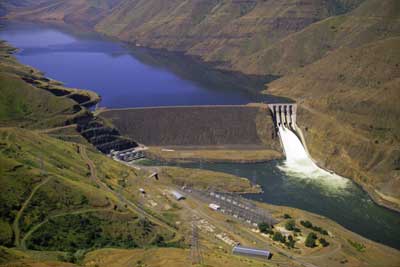forum
library
tutorial
contact

Phosphorous Sewer Rule Could
Cost Local Cities Big Money
by Bryan DooleyIdaho Press Tribune, July 22, 2009
|
the film forum library tutorial contact |

|
Phosphorous Sewer Rule Could
by Bryan Dooley |
No one can explain the recent success, but it's certainly a good sign for endangered fish.
 NAMPA - Nampa Mayor Tom Dale and other Association of Idaho Cities officials believe Treasure Valley communities will have to spend millions of dollars to upgrade sewer treatment.
NAMPA - Nampa Mayor Tom Dale and other Association of Idaho Cities officials believe Treasure Valley communities will have to spend millions of dollars to upgrade sewer treatment.
But Dale hopes to see legislation introduced next year that would give state regulators control over wastewater permits required for cities and some other entities - a step to avoid a much larger expense that could be required by federal regulators.
The difference could halve the expected increase to Nampa sewer users' bills. Information on the possible effects for Caldwell was not available Tuesday.
The federal permits, issued under the National Pollutant Discharge Elimination System program, are required by law for any entity that discharges sewage "into the waters of the United States." Idaho is now one of only four states for which the federal Environmental Protection Agency - rather than the state - issues and enforces the permits.
Tighter standards for phosphorous discharged by cities and some industrial and other entities are on the way, but the effects on local communities could vary widely depending on which government agency has "primacy" for the permit program.
Nampa Public Works Director Michael Fuss said the city expects to receive a draft permit early next year that is likely to drastically reduce the amount of phosphorous the city can discharge.
The change stems from a plan issued by the state Department of Environmental Quality to reduce phosphorous in Brownlee Reservoir, which is on the Snake River in Hells Canyon.
That plan established a target of 70 micrograms per liter, or parts per billion, for the Boise River and its tributary streams, said Barry Burnell, DEQ Water Quality Division Administrator.
EPA would likely require that cities and other entities that must have the federal permits to reduce their discharge to 70 parts per billion at the source, while state regulators would be satisfied with 200 parts per billion, Brunell said.
The cost of the changes will vary from city to city depending on what type of treatment system is currently in place and other factors.
For Nampa, which Fuss said currently averages 5,000 parts per billion, the city is going to have to make substantial changes regardless of which agency oversees the city's wastewater.
However, "the difference between 200 parts per billion and getting down to 70 parts per billion is millions and millions of dollars," Dale said.
Dale was elected Association of Idaho Cities president in June.
Fuss said having the Idaho agency in charge carries two major benefits:
First, the agency has a better understanding of the local "plumbing," he said, than the U.S. Environmental Protection Agency, which manages Idaho's permits from Seattle.
"We're working with a state agency that understands our local environment, and that we have a good working relationship with," Caldwell spokeswoman Maggie Colwell agreed.
Burnell said a major reason for Idaho DEQ's more-lenient requirement is that the agency accounts for the fact that during key summer months, when phosphorous tends to be more of a problem, a large quantity of surface water is withdrawn for irrigation purposes.
Second, Fuss said, the testing model used would likely differ.
EPA's limit would likely be instantaneous, meaning the phosphorous level could not exceed 70 ppb at any time.
DEQ's limit would likely be a seasonal or monthly average, leaving a bit more wiggle room.
EPA generally supports state primacy, Burnell said, but previous efforts in Idaho have been hamstrung by cost worries.
The cost to the state to write, adapt and enforce the permits would have to be funded with some kind of fee-based program, Burnell said.
A resolution issued by the Association of Idaho Cities in June calls on the association and DEQ to prepare an evaluation of the costs, benefits and program funding strategy for a state-administered permit program. It would be considered at AIC's fall Legislative Committee meeting.
Related Pages:
EPA Questions Utility's River Plan by Rocky Barker, Idaho Statesman, 7/12/9
learn more on topics covered in the film
see the video
read the script
learn the songs
discussion forum
